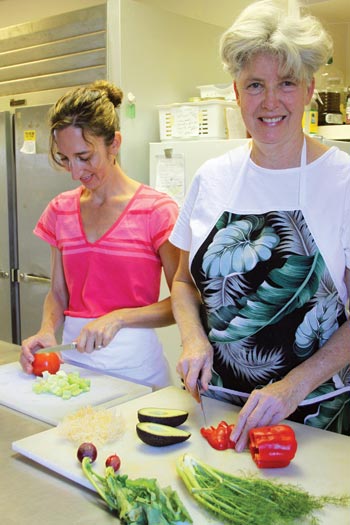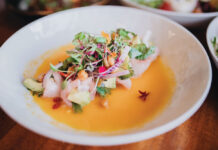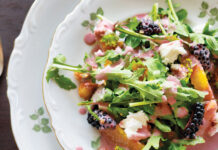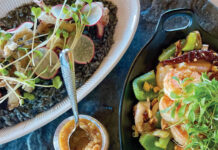Story by Shannon Wianecki | Photography by Nina Lee
 Joy White is a walking advertisement for nutritious eating. Cheerful and easygoing, the silver-haired chef displays boundless energy. After operating South Maui’s most popular health-food restaurant for twelve-plus years, she’s just embarked on an additional adventure: “live food” production.
Joy White is a walking advertisement for nutritious eating. Cheerful and easygoing, the silver-haired chef displays boundless energy. After operating South Maui’s most popular health-food restaurant for twelve-plus years, she’s just embarked on an additional adventure: “live food” production.
I caught up with Joy at her humble café across from Charley Young Beach in Kïhei, where she greets her customers by name. Sandwiches on thick, whole-grain bread, vegan soups made fresh daily, and green power smoothies have acquired loyal fans. Vegetarian bloggers nationwide point to Joy’s Place as the go-to spot for good eats on Maui. They now have a new destination to blog about: the chill case at Whole Foods, which recently started stocking an array of take-away items labeled Joy’s Place Live!
Joy has been serving raw, live food at her restaurant for years, but when the national grocery chain announced it was opening a new store on Maui, she leapt at the opportunity to expand production. She now provides Whole Foods with gingered sauerkraut, kale chips, almond cookies, and lime custard pie all prepared according to the principles of the live-food movement.
“Live food is plant-based,” explains Joy. “It’s vegan and gluten-free, but so much more. It’s all made from soaked and sprouted ingredients, never subjected to temperatures that destroy enzymes.”
“Raw foodists” avoid heating ingredients beyond 116 degrees. They contend that the enzymes found in uncooked foods assist the enzymes produced by the body, to aid in digestion. Live foodists take the concept one step further: not only are the ingredients fresh and uncooked, they’re also soaked and sprouted. Soaking nuts and seeds removes enzyme inhibitors that interfere with absorption of vitamins and minerals.
“When you sprout something,” says Joy, “it adds nutritional value. There’s more life in it.”
Joy tackles the alchemical task of “enlivening” ingredients before her café opens for lunch each day. She invites me back into the small kitchen, which is sunlit and spotless.
“Try this,” she says, handing me half of a peppermint truffle. I pop it into my mouth and experience pure, undiluted flavor: raw cacao butter and nibs kissed by peppermint. Ordinarily I would scarf two or three truffles if given the chance, but this rich treat is satisfying in small portion. Sweetened with local honey rather than refined sugar, it’s even relatively healthy.
“Live food represents a different way of eating,” says Joy. “It’s dense, nutrient packed. You really don’t need to eat so much of it.”
Joy encourages her customers to “eat less, slowly, and savor.”
This is difficult advice to follow where her addictively tasty kale and daikon chips are concerned. Slices of daikon, a mild Japanese radish, are coated in ground cashews, fresh dill, garlic, and onion, and then dehydrated until crispy. The kale chips have a dusting of nutritional yeast, which lends a distinct cheesiness.
Joy’s “burrito supreme” is a far cry from the fast food of the same name: organic lettuce, tomato, avocado, cashew-based “sour cream,” and spicy “bean” mix, which is actually sprouted sunflower seeds blended with jalapeno, chili powder, cilantro, coriander, cayenne, and sea salt, dehydrated and smeared onto a collard-green wrap.
Brilliant pink slivers of gingered sauerkraut make a wonderful garnish on soups or salads. The zesty dish’s bright flavor belies its simple recipe: organic red and green cabbage, fresh local ginger, and Celtic sea salt. Joy prefers Celtic salt because it’s unprocessed, in the same natural state as it was when harvested.
Joy jokes that her red-pepper-cashew spread tastes “just like the old pimento cream cheese,” probably the polar opposite of live food. It’s protein heavy, so she recommends slathering it on something light, like cucumber or celery.
While Joy believes in the health benefits of live foods, she’s anything but a pulpit pounder. “If somebody asks, I’m happy to tell them,” she says. She encourages customers to adopt an attitude of going from good eating habits to better—rather than browbeating themselves for any bad habits of the past. It’s a refreshing perspective.
“Personally, I love meat, pasture-fed butter, all the oils, fish, and whole grains,” she says. “I really don’t recommend an all-live diet.”
Instead, she sees live food as a nutritious alternative to highly processed and sweetened beverages, snacks, and desserts—indulgences that are driving up diabetes rates in this country.
“You can have a beverage that’s not too sugary sweet and is nourishing,” says Joy. “With live sweets, you’re eliminating refined sugar and white flour. The desserts are good, too, because they have coconut oil, which is good for us. We need healthy fats.”
Joy’s tidy kitchen shelves brim with fascinating ingredients: cloudy white coconut oil, tiny hemp seeds, and maca—a Peruvian root traditionally used to improve fertility and boost energy.
From a tub of water, Joy retrieves a clear, tentacled sea vegetable: Irish moss. Most Americans have consumed this alien-looking ingredient, though they may not know it. Labeled as carrageenan, it’s a thickening agent used in place of gelatin in toothpaste, jams, jellies, and ice cream. A reputed superfood, Irish moss is celebrated by nutritionists because of its high vitamin and mineral content.
Joy uses Irish moss to thicken her vanilla and cacao-flavored nut milks. These heavenly draughts are smooth, sweet, and hydrating. Made from soaked almonds, they’re a meal unto themselves—filling without being heavy.
The almond cookies are also delightfully light, with a chewiness reminiscent of macaroons. Rather than baked, the coconut flake, almond powder, and vanilla bean mixture is dehydrated—a process that extends the cookie’s shelf life and maintains crispness without preservatives.
Joy spent a year developing her recipes. When her products were picked up by Whole Foods, she had to formalize her system. The national chain requires a high level of accountability. “We had to get labeled,” says Joy. “We’d like to provide nutritional analysis, too, but it’s hard. A lot of companies don’t recognize ingredients like Irish moss.”
Live food can be complex and time-consuming to produce. Dehydrating, soaking, and sprouting the various components requires commitment and patience.
“I enjoy it,” says Joy. “The challenge is in making it economically viable. Cost effectiveness comes with quantity; that’s why we have to expand.”
That, and the fact that people are snapping up her snacks as quickly as she can make them.
“To me, healthy food never had that burst of flavor that gives you satisfaction, that oomph,” says Joy. “These have that. I’m not boasting; it’s just a reality. It’s balanced and nourishing, and you feel that. It really serves and satisfies your body.”
As a new live-food convert, I have to agree.
Make live foods of your own
Joy White and her right-hand lady, Chef Tyua Sereda, host “Smart Eating” classes once a month at Whole Foods and every other month at Joy’s Place. Classes focus on wholesome, easy-to-find ingredients and quick, no-fuss recipes. (For an example, see this live green soup.) Vegan and live preparations feature organic, local, and seasonal produce. Workshop fee is $45; includes recipes, samples and Q&A session. Preregistration required. Call (808) 385-7779.
Joy’s Place
Island Surf Building: 1993 S. Kihei Rd, Kihei
(808) 879-9258
Whole Foods
70 Ka‘ahumanu Ave., Kahului
(808) 872-3310





